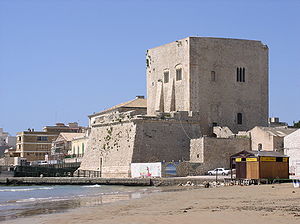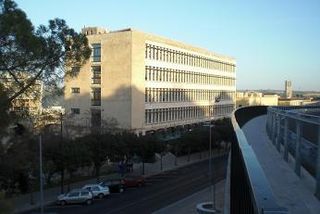
The province of Ragusa was a province in the autonomous region of Sicily, Italy, located in the southeast of the island. Following the abolition of the Sicilian provinces, it was replaced in 2015 by the free municipal consortium of Ragusa. Its capital is the city of Ragusa, Sicily, which is the most southerly provincial capital in Italy.
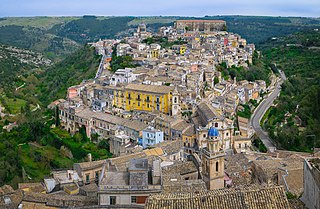
Ragusa is a city and comune in southern Italy. It is the capital of the province of Ragusa, on the island of Sicily, with 73,288 inhabitants in 2016. It is built on a wide limestone hill between two deep valleys, Cava San Leonardo and Cava Santa Domenica. Together with seven other cities in the Val di Noto, it is part of a UNESCO World Heritage Site.

The Chiaramonte are a noble family of Sicily. They became the most powerful and wealthy family in Sicily. In the 13th century the marriage of Manfredi Chiaramonte to Isabella Mosca, united the two Sicilian counties of Modica and Ragusa. Around 1307–1320, the couple built the family seat, the Palazzo Chiaramonte, in Palermo.

Castelbuono is a town and comune in the Metropolitan City of Palermo, Sicily.
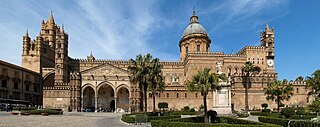
Palermo Cathedral is the cathedral church of the Roman Catholic Archdiocese of Palermo, located in Palermo, Sicily, southern Italy. It is dedicated to the Assumption of the Virgin Mary. As an architectural complex, it is characterized by the presence of different styles, due to a long history of additions, alterations and restorations, the last of which occurred in the 18th century.

Pozzallo is a town and comune in the province of Ragusa, Sicily, southern Italy.
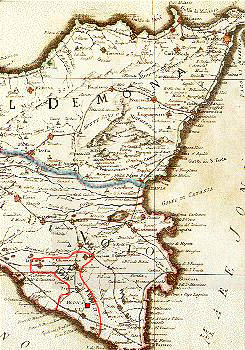
The County of Modica was a feudal territory within the Kingdom of Sicily from 1296 to 1812. Its capital was Modica, on the southern tip of the island, although the cities of Ragusa and Scicli housed some government offices for a period. Today it is perpetuated only as a title held by the head of the House of Alba, Carlos Fitz-James Stuart, 19th Duke of Alba.

The Cathedral of St. Lawrence is a Roman Catholic triple-naved basilica constructed in Romanesque-Gothic in Trogir, Croatia. Since its construction lasted several centuries, it illustrates all the styles that succeeded one another in Dalmatia. It serves now as the most imposing monument in the city of Trogir.
Sclafani is an Italian noble family.

The Palace of the Kings of Navarre of Olite or Royal Palace of Olite is a castle-palace in the town of Olite, in Navarre, Spain. It was one of the seats of the Court of the Kingdom of Navarre, since the reign of Charles III "the Noble" until its conquest by Castile (1512).
Surely there is no king with a more beautiful castle or palace and with so many gilded rooms (...) it could not say or even could imagine how magnificent and sumptuous is this palace (...)

The Castle of Conversano is located on the highest point of the hill on which the city stands in a position able to dominate the whole surrounding territory to the sea, and borders the old Largo della Corte, a large irregularly shaped square always at the heart of the city life.
Catalan Gothic is an artistic style, with particular characteristics in the field of architecture. It occurred in the Principality of Catalonia within the Crown of Aragon between the 13th and 15th centuries, which places it at the end of the European Gothic period and at the beginning of the Renaissance. The term Catalan Gothic is confined to Barcelona and its area of influence, which has its own characteristics.

Bellesguard, also known as Casa Figueres, is a modernist manor house designed by Catalan architect Antoni Gaudí, which was constructed between 1900 and 1909.

The Old Cathedral of Plasencia is a Roman Catholic church in Plasencia, Cáceres Province, Extremadura, Spain. It is one of two cathedrals in Plasencia, the other being the New Cathedral.
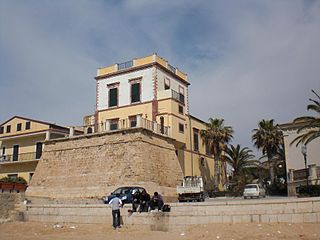
The Torre Cabrera, also known as Torre Mazzarelli, Torre della Dogana or Torre di Gaddimeli, is a 16th-century tower in Marina di Ragusa, a frazione of Ragusa, Sicily.

Palazzo Correr Contarini Zorzi is a Renaissance palace in Venice, Italy, overlooking the Grand Canal and locating in the Cannaregio district between Palazzo Querini Papozze and Palazzo Gritti. The palazzo is also known as Ca' dei Cuori, a family whose wrought iron coats of arms is present on the façade.

The Visconti Castle is a medieval fortification that stands south of Legnano on a natural island in the Olona River. It has also been known as the castle of San Giorgio since the 13th century. The architectural complex is located on Viale Toselli, between Castello Park and Piazza I Maggio.
Andrea Chiaramonte was a representative of the Sicilian nobility in the 14th century.

The Nassauer Haus or Schlüsselfeldersche Stiftungshaus in Nuremberg is a medieval residential tower made of so-called red castle sandstone. Although originally built in Romanesque style, after several reconstructions the house is still characterized by Gothic style elements. It is the last still existing residential tower in Nuremberg.
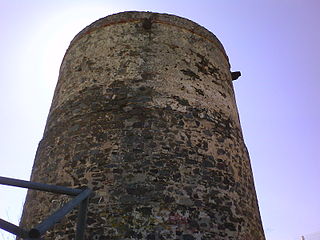
The Torre del Catalán is a watchtower located in Lepe, in the province of Huelva (Spain), declared Bien de Interés Cultural.
